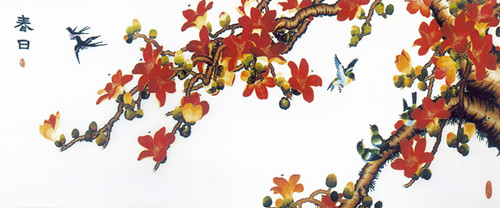Yue Embroidery
Also called Guang embroidery, Yue embroidery is a general name for embroidery products of the regions of Guangzhou, Shantou, Zhongshan, Fanyu and Shunde in Guangdong Province. According to historical records, in the first year of Yongyuan's reign (805) during the Tang Dynasty (618-907), a girl named Lu Meiniang embroidered the seventh volume of the Fahua Buddhist Scripture on a piece of thin silk 30 cm long. And so, Yue embroidery became famous around the country.
The prosperous Guangzhou Port of the Song Dynasty promoted the development of Yue embroidery, which began to be exported at that time. During the Qing Dynasty, people animal hair as the raw material for Yue embroidery, which made the works more vivid. During Qianlong's reign (1736-1796) of the Qing, an industrial organization was established in Guangzhou. At that time, a large number of craftsmen devoted themselves to the craft, inciting further improvements to the weaving technique. Since 1915, the work of Yue embroidery garnered several awards at the Panama Expo.
Influenced by national folk art, Yue embroidery formed its own unique characteristics. The embroidered pictures are mainly of dragons and phoenixes, and flowers and birds, with neat designs and strong, contrasting colors. Floss, thread and gold-and-silk thread embroidery are used to produce costumes, decorations for halls and crafts for daily use.
 |
| Yue embroidery work, Springtime [Photo/gzzxws.gov.cn] |
Embroidery in China
Embroidery is a brilliant pearl in Chinese art. From the magnificent Dragon Robe worn by Emperors to the popular embroidery seen in today's fashions, embroidery adds so much pleasure to our life and our culture.
As a folk art with a long tradition, Embroidery occupies an important position in the history of Chinese arts and crafts. It is, in its long development, inseparable from silkworm-raising and silk-reeling and weaving.
China is the first country in the world that discovered the use of silk. Silkworms were domesticated as early as 5000 years ago. The production of silk thread and fabrics gave rise to the art of embroidery. According to the classical Shangshu (or Book of History), the "regulations on costumes" of 4000 years ago stipulated among other things "dresses and skirts with designs and embroideries". This is evidence that embroidery had become an established art by that remote time.



 Print
Print Mail
Mail
